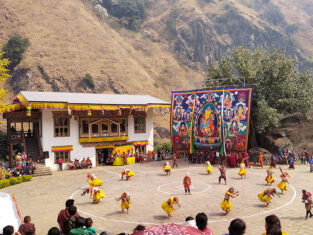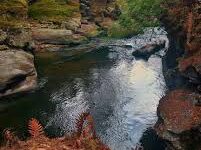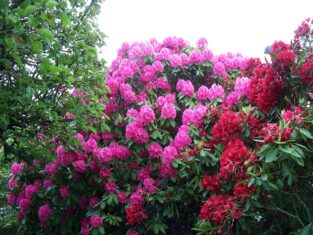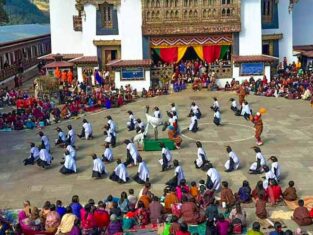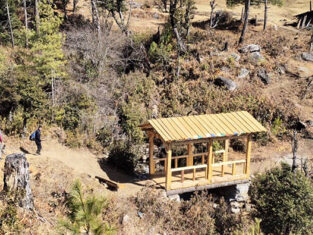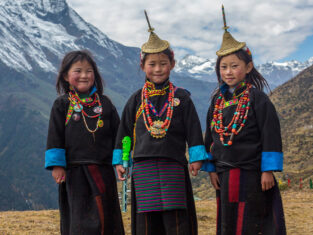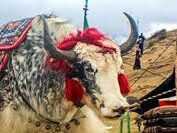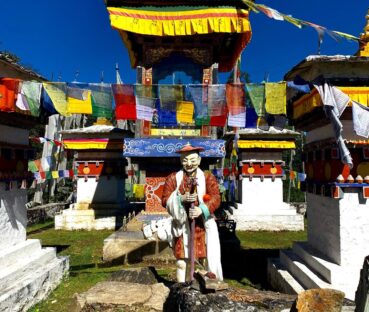
Explore Eastern Bhutan
Destination: 10 Nights / 11 Days
Destination Covered : Paro, Thimphu, Wangdue, Trongsa, Bumthang, Mongar, Trashigang and Trashiyangtse
Tour Activities : Museums, Sightseeing, etc.
Tour Themes : Hill Stations & Valleys, Religious & Pilgrimage, Culture & Heritage
Fill Enquiry Form Below
Bhutan Culture Overview
An invitation to explore the intricacy of Bhutanese culture and heritage that is sure to leave an indelible mark on your heart.
Traditional Architecture
On the mountain tops, cliff faces and in the valleys of Bhutan, you will find ornately designed and crafted dzongs or fortresses, monasteries, and traditional houses. Adorned with colorful paintings and attention-demanding carvings, these architectural marvels are a peek into Bhutan’s unique craftsmanship.
These ancient fortresses are religious and administrative centers, holding significance in the Bhutanese culture with some housing sacred relics while others serve as hubs for community gatherings and religious activities.
Culture and Etiquette
The essence of Bhutanese culture stands on its respect for elders, reverence for nature, and a strong sense of community.
A established sense of belongingness and togetherness is seen in the community where respect is expressed by addition of “la” at the end of a sentence when talking to someone else irrespective of their age. Where a younger might address some older as "Aue," meaning elder sibling irrespective of their known relation.
Other manners of etiquette can be noted in every Bhutanese in everyday life. Embracing these cultural norms lets you get a feel of what it truly means to be a part of Bhutan.
Traditional Attire
Fabled to have the largest pocket in the world, the national dress of Bhutan known as Gho (for men) and Kira (for women) is an integral part of being a Bhutanese. These garments are a vibrant symbol of Bhutanese culture and tradition and are worn on all occasions, festivals, and even everyday life.
The gho is a knee-length robe adorned with intricate patterns, paired with knee-high socks and leather boots while the kira is an ankle-length dress wrapped elegantly around the body and often held together by a handwoven, traditional belt and complemented by a blouse and a colorful sash or rachu.
The Bhutanese attire showcases vibrant colors and patterns elaborately woven, passionately reflecting Bhutan’s diverse traditions and skilled craftsmanship. During the festivals and ceremonies, captivating jewelry embellishes the attire. The national dress of Bhutan is a timeless piece of elegance that captivates the soul.
Cuisine and Hospitality
A mix of everything Himalayan, the cuisine of Bhutan reflects the improvisation and adaption the Bhutanese made, giving birth to the rich palatal diversity.
You can savor spicy hot dishes like ema datsi (chili and cheese stew), snack on soft and plump momos (dumplings), or calm your nerves with suja (butter tea), while admiring the majestic landscapes of Bhutan and finding comfort in the warmth and hospitality of Bhutanese families and guesthouses.
Share a meal, a laugh or two, and endless memories.
Creativity
Despite its small size, Bhutan fosters a wide range of creativity. From traditional arts and crafts to modern arts and sculpting. From traditional masked dances to modern street dancers, we house it all.
More often than not, you can find yourself amidst a mix of traditional and modern art forms in the heart of Bhutan’s capital, Thimphu.
If you want a quiet time, you can take a stroll in one of the multiple art galleries and museums. You can meet the local artists at VAST (voluntary art studio Thimphu) and even share a drink or two.
If your dancing shoes are clacking, drop by the GOKAB studio and get grooving with Bhutanese dancers.
If you ever need a creative break, come to Bhutan.
Detailed Tour Itinerary
Day 1: Arrival in Paro
- Arrive at Paro International Airport.
- Our guide and driver will receive you from the airport.
- Visit Kyichu Lhakhang. It was originally built in 7th century and Padmasambhava visited in 8th century.
Day 2: Paro to Trongsa
- Visit Chimi Lhakhang. It was built in 1499 and it stands on a round hillock.
Day 3: Trongsa to Bumthang
- Visit Trongsa Dzong: It is built on a spur overlooking the gorge of the Mangde River. Initially a temple was first established in 1543, in 1647 Zhabdrung Ngawang Namgyal constructed the first dzong to replace temple and called Chökhor Rabtentse Dzong with a shorter version of Choetse Dzong.
- Visit Kurjey Monastery: Kurjey Monastery stands magnificently in Chokor Valley of Bumthang. It was built by Minjur Tempa in 1652.
Day 4: Bumthang to Mongar
- Take a quick break at Thrimsungla to enjoy the beautiful view.
Day 5: Mongar to Trashiyangtse
- Visit Gomphu Kora: Gomphu meaning ‘a sacred meditation site of Guru Rinpoche’ and Kora meaning ‘Circumbulation’. It is believed that Guru Rinpoche has visited the place and meditated in 8th Century.
- Visit Chorten Kora: Chorten Kora is an important stupa next to the Kholongchu River in Trashi Yangtse. The stupa was built in the 15th century by Lama Ngawang Lodröe, in order to subdue a harmful demon believed to have been living at the site where the stupa is now located. The stupa is modeled after the famous Boudhanath stupa in Nepal popularly known as Jarung Khashor.
Day 6: Trashigang to Merak
- Visit Yue Pemachen: It is a place where Lhasey Kuentu Legpa lived in 7th century and Lam Jerrapa in 13th century. Remains of Architectures and monuments are found till date. The community today has unique culture, language, tradition and dress code.
- Visit place where Ganapati lived in 17th century. Remains of beautiful architectures are found till date.
- Visit Merak: The nomad community has unique culture, language, tradition and dress code.
- Experienced their unique culture and traditional.
Day 7: Trashigang to Sakteng
- Visit Sakteng: The nomad community has unique culture, language, tradition and dress code.
- Experienced their unique culture and traditional.
Day 8: Trashigang to Bumthang
- Visit Wadipa (Cow harder) Ney: In 7th century when Guru Rinpoche was travelling to eastern Bhutan stopped at this point. It is believed that Wadipa received a blessing from Guru Rinpoche at same place.
Day 9: Bumthang to Phobjikha
- Visit Mebartsho: Mebar Tsho means burning lake. The lake is renowned for its beauty, serenity and sacredness from spiritual point of view.
Day 10: Phobjikha to Paro
- Gangtey Nature Trail Hike: The most beautiful and shortest of the existing nature trails in Bhutan. The hike takes about 1hr 30minutes through the pine forest and small bamboo plants. You can see the beautiful Phobjikha valley from this hike. During the winter months, we can see the endangered species of birds – Black Neck Cranes.
Day 11: Departure
- Depart from Paro Airport
Fill Enquiry Form Below
Contact us for detailed tour itinerary and customization
Fill Enquiry Form Below


